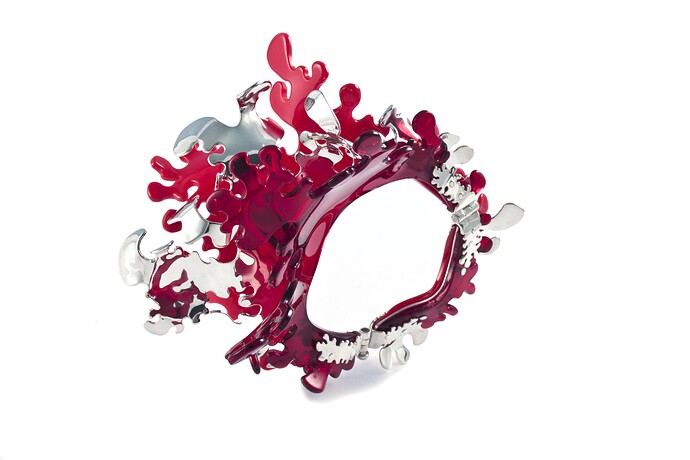Materials: Acrylic, sterling silver
Dimensions: 10cm x 13cm x 9cm
Sterling silver sheets, hand sawed, forged and formed. Filed, sanded and polished. Sculpted and thermoformed acrylic. Riveted. Hinged bracelet.
Finish: mirror polished
Photo credit: Oriane Meyer
Magali Thibault Gobeil
St-Lambert, Quebec. Canada
Life, nature, existence itself, is all just contrast, opposition and contradiction. This duality is the essence of everything that surrounds us and builds us. Absolute truth does not exist. Only constant experimentation allows us to query the existing paradigms. One thing can be it and its opposite, at the same time. This relativity, often accompanied by wisdom, fascinates, excites and inspires me.
Inspired by the pure and organic nature as well as the industrial and "grunge" side of the city, I create ready-to-wear sculptures with original and vibrant contrasts. This opposition between crude and refined, between the organic and the geometric, between the pure and the impure, merge to give birth to pieces strong in contrasts and emotions but also filled with a new vision on things. A symbiosis between the pure and incongruous materials gives rise to remarkable works, but also allows new questioning and push the limits in modern jewelry.
My work that combines delicacy and femininity, sprinkled with a touch of eccentricity, are created using the techniques of traditional jewelry making, but also by using tools, techniques, and processes more innovative that come from any other fields. This is why opening these new horizons, not only by merging techniques but also materials, redefines the jewel itself. This alliance between traditional and new methods allows to transcend the limitations of contemporary jewelry and to bring further. In another world; mine.
The exhibition explores metal works whose primary theme is color embraced as their primary visual focus, whether that be using colored materials, exploring creating colored surfaces, or encasing the object in color.
As the world's largest jewelry related internet site, Ganoksin strives to develop exhibitions showcasing work from around the world. This exhibition was open to all metalsmiths, professional and amateur, advanced and beginner.
In total 303 artists contributed 814 show pieces for the permanent online exhibition.
The exhibition was curated by Beth Wicker, President of the North Carolina Society of Goldsmiths in the United States, and Adjunct Instructor at Northeastern Technical College in South Carolina. Director of the exhibition is Hanuman Aspler, founder of The Ganoksin Project, the world's largest internet jewelry site.
Hue is one of the primary properties of color, it refers to the place the color occupies on the visual spectrum. Humans have used hues throughout time, to create cave paintings, to decorate themselves, their clothing and their housing.
Different hues have taken on different meanings throughout time. Gold traditionally has been a color of purity - the metal gold is relatively unchangeable, and the hue of gold has come to stand for gods and goddesses, for royalty, for durability and for purity. Red has often meant love, or passion. Hues often reflect the meaning of the seasons, with pastels referring to spring and the burst of new life after the pale hues of winter. Summer is reflected in vibrant, deep hues, followed by the browning of hues in the fall as plants go to seed and die, and the land turns fallow.
The worth of a hue has often been tied to what is necessary to make the pigment that creates the hue, and the expensive involved in the process. Often created from crushed stones that had to be mined and carried by caravan over thousands of miles, or from fermented roots of plants only grown in certain areas, or the carapaces of rare insects - the creation of hue in a way that could be used by man was an involved and generally expensive process.
In today's world metalsmiths have access to perhaps the widest range of materials and hues in the history of man - and in some of the most affordable ways ever.
This exhibition celebrates hue - color - as an integral, inherent element of the work. We talk of the "richness" of color, and examples of this abound here. One expects hues from the colors of gemstones used in metalsmithing, but we also have hues from some less expected places. Glass enamels are an ancient way of adding color, as are a variety of patinas. Today's artists also use synthetic man-made materials to add color in ways that didn't exist a century ago.
We invite you to enjoy this celebration of hue, and the ways hues and their use have changed over time.
